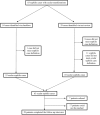Increases in Ocular Syphilis-North Carolina, 2014-2015
- PMID: 29020152
- PMCID: PMC5740484
- DOI: 10.1093/cid/cix604
Increases in Ocular Syphilis-North Carolina, 2014-2015
Abstract
Background: Ocular syphilis is an inflammatory eye disease due to Treponema pallidum infection. In the United States, syphilis rates have increased since 2000; clusters of ocular syphilis were reported in 2015. We investigated ocular syphilis in North Carolina to describe the epidemiology and clinical course of disease.
Methods: We reviewed syphilis cases reported to North Carolina during 2014-2015 and abstracted information from health department interviews for cases with ocular symptoms and no other defined etiology. To assess duration and severity of ocular symptoms, we also reviewed medical records and conducted structured interviews. We compared the prevalence of ocular manifestations among reported syphilis cases by demographic and clinical characteristics.
Results: Among 4232 syphilis patients, 63 (1.5%) had ocular syphilis: 21 in 2014 and 42 in 2015, a 100% increase. Total syphilis cases increased 35% through 2015. No patient with ocular syphilis named another ocular syphilis patient as a sex partner. Patients presented in all syphilis stages; 24 (38%) were diagnosed in primary or secondary syphilis. Ocular manifestations were more prevalent among syphilis patients who were male, aged ≥40 years, white, and infected with human immunodeficiency virus. No risk behaviors were associated with ocular syphilis. Among 39 interviewed patients, 34 (87%) reported reduced vision during infection; 12 (31%) reported residual visual symptoms posttreatment.
Conclusions: In North Carolina, ocular syphilis increased from 2014 to 2015 and may be due to increased recognition of ocular manifestations, or a true increase in ocular syphilis. Many ocular syphilis patients experienced vision loss; however, most improved posttreatment.
Keywords: Treponema pallidum; epidemiology; surveillance; syphilis; vision loss.
Published by Oxford University Press for the Infectious Diseases Society of America 2017. This work is written by (a) US Government employee(s) and is in the public domain in the US.
Conflict of interest statement
Figures


References
-
- Centers for Disease Control and Prevention. Sexually transmitted disease surveil-lance 2015. Atlanta, GA: US Department of Health and Human Services; 2016.
-
- Kiss S, Damico FM, Young LH. Ocular manifestations and treatment of syphilis. Semin Ophthalmol. 2005;20:161–7. - PubMed
-
- Spoor TC, Wynn P, Hartel WC, Bryan CS. Ocular syphilis. Acute and chronic. J Clin Neuroophthalmol. 1983;3:197–203. - PubMed
-
- Ormerod LD, Puklin JE, Sobel JD. Syphilitic posterior uveitis: correlative findings and significance. Clin Infect Dis. 2001;32:1661–73. - PubMed
MeSH terms
Grants and funding
LinkOut - more resources
Full Text Sources
Other Literature Sources
Medical

